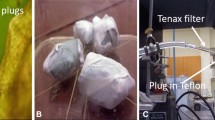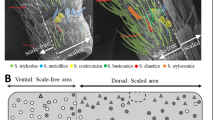Abstract
Inhibition of the behavioral responses of maleEpiphyas postvittana moths by theZ isorner of the major component of the sex pheromone,E11-14: OAc, was studied in a wind tunnel. Inhibition was detectable at a Z isomer concentration of 10% that of the major component and was greatest when it was added to the same source as the pheromone. Inhibition declined rapidly as the inhibitor was moved across-wind away from the pheromone source but was largely maintained when the sources were separated upwind or downwind. The results showed that the insects possess a high degree of temporal resolution for odor plumes of different composition.
Similar content being viewed by others
References
Bartell, R.J. 1982. Problems in identifying multicomponent sex pheromones,in R.A. Galbraith (ed.). Insect Pheromones and Their Application. DSIR Entomology, New Zealand, Report 2.
Bellas, T.E., Bartell, R.J., andHill, A. 1983. Identification of two components of the sex pheromone of the moth,Epiphyas postvittana (Lepidoptera, Tortricidae).J. Chem. Ecol. 9:503–512.
Bossert, W.H., andWilson, E.O. 1963. The analysis of olfactory communication among animals.J. Theor. Biol. 5:443–469.
Daterman, G.E., Daves, G.D., andSmith, R.G. 1975. Comparison of sex pheromone versus an inhibitor for disruption of pheromone communication inRhyacionia buoliana.Environ. Entomol. 4:944–946.
Kaae, R.S., Shorey, H.H., Gaston, L.K. andHummel, H.H. 1974. Sex pheromones of Lepidoptera: Disruption of pheromone communication inTrichoplusia ni andPectinophora gossypiella by permeation of the air with nonpheromone chemicals.Environ. Entomol. 3:87–89.
Kaissling, K.-E. 1986. Temporal characteristics of pheromone receptor cell responses in relation to orientation behaviour of moth, pp. 193–200,in T.L. Payne, M.C. Birch, and C.E.J. Kennedy (eds.). Mechanisms in Insect Olfaction. Clarendon Press, Oxford.
Kramer, E. 1986. Turbulent diffusion and pheromone-triggered anemotaxis, pp. 59–68,in T.L. Payne, M.C. Birch, and C.E.J. Kennedy (eds.). Mechanisms in Insect Olfaction. Clarendon Press, Oxford.
Liu, Y.-B., andHaynes, K.F. 1992. Filamentous nature of pheromone plumes protects integrity of signal from background chemical noise in cabbage loop moth,Trichoplusia ni.J. Chem. Ecol. 18:299–307.
McLaughlin, J.R., Mitchell, E.R., Chambers, D.L., andTumlinson, J.H. 1974. Perception of Z-7-dodecen-1-ol and modification of the sex pheromone response of male loopers.Environ. Entomol. 3:677–680.
Mitchell, E.R. 1976. Inhibition of pheromone perception by male cabbage loopers and beet armyworms: Proximity vs. atmospheric permeation.Environ. Entomol. 5:770–772.
Murlis, J. 1986. The structure of odour plumes, pp. 27–38,in T.L. Payne, M.C. Birch, and C.E.J. Kennedy (eds.). Mechanisms in Insect Olfaction. Clarendon Press, Oxford.
Murlis, J., andJones, C.D. 1981. Fine-scale structure of odour plumes in relation to insect orientation to distant pheromone and other attractant sources.Physiol. Entomol. 6:71–86.
Priesner, E. andWitzgall, P. 1984. Modification of pheromonal behaviour in wildColeophora laricella male moths by (Z)-5-decenyl acetate, an attraction-inhibitor.Z. Angew. Entomol. 98:118–135.
Roelofs, W.L., andComeau, A. 1971. Sex pheromone perception: synergists and inhibitors for the red-banded leaf roller attractant.J. Insect Physiol. 17:435–448.
Rumbo, E.R. 1993. Interactions between male moths of the lightbrown apple moth,Epiphyas postvittana (Walker) (Lep.: Tort.), landing on synthetic sex pheromone sources in a windtunnel.Physiol. Entomol. In press.
Rumbo, E.R., andKaissling, K.-E. 1989. Temporal resolution of odour pulses by three types of pheromone receptor cells in Antherea polyphemus.J. Comp. Physiol. (A) 165:281–291.
Shorey, J.J., andHale, R.L. 1965. Mass-rearing of the larvae of nine noctuid species on a simple artificial medium.J. Econ. Entomol. 58:522–524.
Sower, L.L., Vick, K.W., andBall, K.A. 1974. Perception of olfactory stimuli that inhibit the responses of male phycitid moths to sex pheromones.Environ. Entomol. 3:277–279.
Witzgall, P., andPriesner, E. 1991. Wind-tunnel study on attraction inhibitor in maleColeophora laricella Hbn. (Lepidoptera: Coleophoridae).J. Chem. Ecol. 17:1355–1362.
Author information
Authors and Affiliations
Rights and permissions
About this article
Cite this article
Rumbo, E.R., Deacon, S.M. & Regan, L.P. Spatial discrimination between sources of pheromone and an inhibitor by the light-brown apple mothEpiphyas postvittana (Walker) (Lepidoptera: Tortricidae). J Chem Ecol 19, 953–962 (1993). https://doi.org/10.1007/BF00992530
Received:
Accepted:
Issue Date:
DOI: https://doi.org/10.1007/BF00992530




